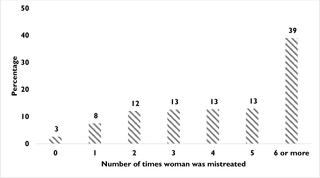PLOS ONE ( IF 3.7 ) Pub Date : 2018-03-16 , DOI: 10.1371/journal.pone.0194601 Waqas Hameed , Bilal Iqbal Avan

|
Introduction
Respectful and dignified healthcare is a fundamental right for every woman. However, many women seeking childbirth services, especially those in low-income countries such as Pakistan, are mistreated by their birth attendants. The aim of this epidemiological study was to estimate the prevalence of mistreatment and types of mistreatment among women giving birth in facility- and home-based settings in Pakistan in order to address the lack of empirical evidence on this topic. The study also examined the association between demographics (socio-demographic, reproductive history and empowerment status) and mistreatment, both in general and according to birth setting (whether home- or facility-based).
Material and methods
In phase one, we identified 24 mistreatment indicators through an extensive literature review. We then pre-tested these indicators and classified them into seven behavioural types. During phase two, the survey was conducted (April-May 2013) in 14 districts across Pakistan. A total of 1,334 women who had given birth at home or in a healthcare facility over the past 12 months were interviewed. Linear regression analysis was employed for the full data set, and for facility- and home-based births separately, using Stata version 14.1.
Results
There were no significant differences in manifestations of mistreatment between facility- and home-based childbirths. Approximately 97% of women reported experiencing at least one disrespectful and abusive behaviour. Experiences of mistreatment by type were as follows: non-consented care (81%); right to information (72%); non-confidential care (69%); verbal abuse (35%); abandonment of care (32%); discriminatory care (15%); and physical abuse (15%). In overall analysis, experience of mistreatment was lower among women who were unemployed (β = -1.17, 95% CI -1.81, -0.53); and higher among less empowered women (β = 0.11, 95% CI 0.06, 0.16); and those assisted by a traditional birth attendant as opposed to a general physician (β = 0.94, 95% CI 0.13, 1.75). Sub-group analyses for home-based births identified the same significant associations with mistreatment, with ethnicity included. In facility-based births, there was a significant relationship between women’s employment and empowerment status and mistreatment. Women with prior education on birth preparedness were less likely to experience mistreatment compared to those who had received no previous birth preparedness education.
Conclusion
In order to promote care that is woman-centred and provided in a respectful and culturally appropriate manner, service providers should be cognisant of the current situation and ensure provision of quality antenatal care. At the community level, women should seek antenatal care for improved birth preparedness, while at the interpersonal level strategies should be devised to leverage women’s ability to participate in key household decisions.
中文翻译:

妇女在分娩期间遭受虐待的经历:巴基斯坦家庭和设施出生的比较
介绍
尊重和有尊严的医疗保健是每位妇女的基本权利。但是,许多寻求分娩服务的妇女,特别是那些在巴基斯坦等低收入国家的妇女,受到接生员的虐待。这项流行病学研究的目的是估计在巴基斯坦设施和家庭环境中分娩的妇女中,虐待的发生率和虐待的类型,以解决缺乏有关该主题的经验证据的情况。这项研究还检查了人口统计学(社会人口统计学,生殖史和赋权状况)与虐待之间的联系,无论是一般情况还是根据出生情况(无论是家庭还是家庭)。
材料与方法
在第一阶段,我们通过广泛的文献综述确定了24种虐待指标。然后,我们对这些指标进行了预测试,并将其分为七种行为类型。在第二阶段,该调查于2013年4月至5月在巴基斯坦的14个地区进行。在过去的12个月中,总共对1,334名在家里或在医疗机构分娩的妇女进行了采访。使用Stata版本14.1,对所有数据集进行线性回归分析,并对设施和家庭出生的婴儿分别进行线性回归分析。
结果
设施分娩和家庭分娩的虐待表现没有显着差异。大约97%的妇女报告经历了至少一种不尊重和辱骂的行为。按类型分列的虐待经历如下:未经同意的护理(81%);知情权(72%); 非机密护理(69%);口头虐待(35%); 放弃护理(32%);歧视性照顾(15%);和身体虐待(15%)。总体而言,失业妇女遭受虐待的比例较低(β= -1.17,95%CI -1.81,-0.53);在无权的女性中更高(β= 0.11,95%CI 0.06,0.16);以及那些由传统接生员而不是普通医生协助的人(β= 0.94,95%CI 0.13,1.75)。对家庭出生的婴儿进行的亚组分析确定了与虐待相同的重要关联,其中包括种族。在以设施为基础的分娩中,妇女的就业与赋权状况和虐待之间存在着显着的关系。与先前没有接受过备胎教育的妇女相比,接受过备胎教育的妇女遭受虐待的可能性较小。
结论
为了促进以妇女为中心并以尊重和在文化上适当的方式提供护理,服务提供者应认识到当前的状况并确保提供优质的产前护理。在社区一级,妇女应寻求产前护理,以改善生育准备,而在人际关系方面,应制定战略以利用妇女参与关键家庭决策的能力。


























 京公网安备 11010802027423号
京公网安备 11010802027423号